Impressions of a Canadian Agilityphile
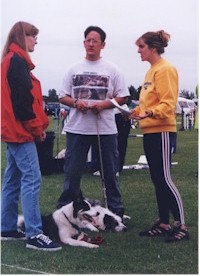 It
all began when Deb Witmer sent an innocent e-mail to the AGILE email list asking about trials
in Scotland during the time of their vacation. Much to her surprise, she received several
enthusiastic replies containing information about trials, dates and websites that could help.
She and her husband Tom were home-based in Callandar for a week. This article about their visit
to the East Lothian DTC Dog Agility Show on the weekend of 17 July was written with a Canadian
audience in mind. It
all began when Deb Witmer sent an innocent e-mail to the AGILE email list asking about trials
in Scotland during the time of their vacation. Much to her surprise, she received several
enthusiastic replies containing information about trials, dates and websites that could help.
She and her husband Tom were home-based in Callandar for a week. This article about their visit
to the East Lothian DTC Dog Agility Show on the weekend of 17 July was written with a Canadian
audience in mind.
The trial site, the Meadowmill Sports Centre in
Prestonpans, East Lothian, was a wonderful sports field and complex, and my initial impression
was lots of people and lots of dogs. This is really BIG!!!
Introduction
I approached the office tent and asked to have my hosts Campbell and Lorna Whytock
paged over the loudspeaker system (what luxury!). Never having met before and with hundreds of
people and dogs milling about, I had no other choice. Sorry to spook you Campbell. Really there
was nothing wrong with your scores!!!!
 Campbell, Lorna and Brook (their pooch) spent time explaining how agility happens in Scotland,
introducing me around, and even letting me tag along to walk the Jumpers and Pairs Jumpers
course.
Campbell, Lorna and Brook (their pooch) spent time explaining how agility happens in Scotland,
introducing me around, and even letting me tag along to walk the Jumpers and Pairs Jumpers
course.
I was quite impressed with the ability of a club to run
four rings. For such a large trial the atmosphere was very relaxed, with competitors and their
dogs knowing when to show and calmly presenting themselves to the gate steward for their scribe
sheet.
 Our Canadian system of obtaining Qís (qualifying runs) that lead to a title of some sort (if
youíre lucky Ė God how many more years before we get our Masters?) does not exist in Scotland.
There, you need to come first in your class in order to move up. I understand that bottlenecks
exist and I have to say I really wonder how so many people with slower dogs stay interested in
the sport. Could it have something to do with the very active social life of a Scottish trial?
Of course, one of the early things Campbell pointed out to me was the huge party tent where the
disco happens on Saturday night. Fortunately, the field is also littered with trailers and
tents so after the party you can walk home. The only risk to your run the next day may be a
hangover.
Our Canadian system of obtaining Qís (qualifying runs) that lead to a title of some sort (if
youíre lucky Ė God how many more years before we get our Masters?) does not exist in Scotland.
There, you need to come first in your class in order to move up. I understand that bottlenecks
exist and I have to say I really wonder how so many people with slower dogs stay interested in
the sport. Could it have something to do with the very active social life of a Scottish trial?
Of course, one of the early things Campbell pointed out to me was the huge party tent where the
disco happens on Saturday night. Fortunately, the field is also littered with trailers and
tents so after the party you can walk home. The only risk to your run the next day may be a
hangover.
 In terms of the equipment, everything matched with each ring having its own colour scheme. The
jumps use one bar only and there are two jump heights. I actually saw a larger sheltie that had
to jump 30 inches!!!
In terms of the equipment, everything matched with each ring having its own colour scheme. The
jumps use one bar only and there are two jump heights. I actually saw a larger sheltie that had
to jump 30 inches!!!
Both the broad jump and the wishing well jump, two pieces
of equipment I have yet to see used in a course in my five years of agility here in Canada,
were in use in one of the rings that day. The handlers comments I overheard about the wishing
well jump told me they hadnít been using it either. However, the table, a staple in our
courses, is rarely used and if it is, it is usually only as a time stopper (The table count, I
was told, takes up too much time to be used in a course).
 Letís
talk about volume Letís
talk about volume
I was amazed to learn that a trial will enter 350Ė400 dogs and put through about 4000 runs in a
weekend!!!! Chances are that you and your dog will have ten runs in a weekend at about £1.50
per run (thatís about 3.50CD). Compare this to events we participate in through Agility
Association of Canada (AAC) where you get four runs per weekend at a cost of
$12-15 per run. Maybe we need to go really big in Canada as there appears to be
a significant cost advantage to both the club and competitors when run on larger
scale.
However, volume isnít always the best as one class will
have over 200 runs. The odds of a ribbon plummet drastically. Imagine what the walk-throughs
are like, jostling elbows with that many people! And imagine knowing that you are 215th to go
in for your run!!!
 Handling
challenges Handling
challenges
The Jumpers course I walked presented handling challenges but didnít seem to have the glaring
traps while the other courses didnít seem to offer the 'work away' opportunities or confusing
repeats that Canadian agility seems to be so fond of. The angles seemed to be the greatest
challenge in addition to being able to nail the contacts when you and your dog are blazing
around the course. In the end, a lot of the handling I observed was very smooth and confident,
making it all look so easy and natural.
 Time is everything
Time is everything
Few handlers are aware of the course time and just go out and run their fastest. If the timing
fails for one reason or another, the dog is allowed to finish the course and reruns the course
for time only, keeping any faults incurred during the first round but not picking up any more
faults if they occur in the second.
I have to say, though I found the ring sides very quiet.
I have become used to the spectators and judges showing appreciation after a run and wondered a
bit at the rather subdued response to the team efforts on the course. Maybe it was the party
the night before?
Oh Ė and get thisÖ..they even take time out for a
one-hour lunch break!!!!
 For those
of you waiting with baited breath, I apologise that I am unable to make a 'port-a-potty'
assessment as I couldnít find one to visit. Iím not sure where that puts this trial in the
rankings. Sorry to disappoint you. For those
of you waiting with baited breath, I apologise that I am unable to make a 'port-a-potty'
assessment as I couldnít find one to visit. Iím not sure where that puts this trial in the
rankings. Sorry to disappoint you.
In closing I wish to thank Campbell and Lorna for
responding to my call for help and guiding me to experience a Scottish agility trial. You
certainly impressed this Canuck!!!!
 About the author...
About the author...
Deb Witmer runs her one and only six year old yellow labrador Teddy in Southern Ontario at
the Masterís level. She estimates that at this rate Ted will be 13 1/2 when he finally has his
Masterís title.
Holiday snaps by Deb.
|